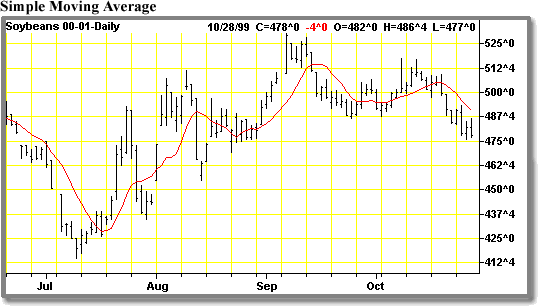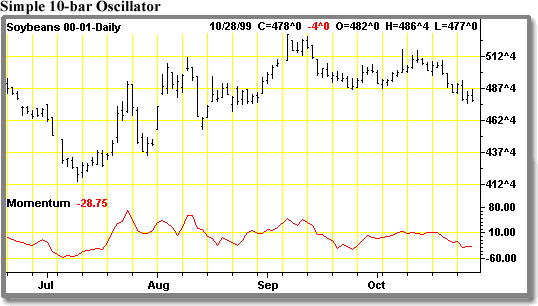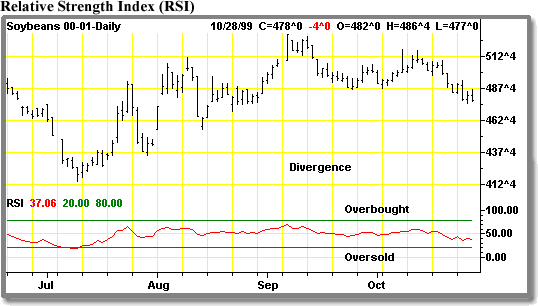|
Technical indicators are additional tools used by the technician in order to develop commodity price forecasts. In this section you will examine a few of the more popular technical indicators used to supplement the basic analytical tools of support, resistance and trendlines. These include; moving averages and oscillators.
The moving average is a trend following indicator which is easy to construct and one of the most widely used mechanical trend following systems used. A moving average, as the name suggests, represents an average of a certain body of data that moves through time. The most common way to calculate the moving average is to work from the last 10 days of closing prices. Each day, the most recent close ( day 11) is added to the total and the oldest close ( day 1) is subtracted. The new total is then divided by the total number of days ( 10) and the resultant average computed.
The purpose of the moving average is to track the progress of a price trend. The moving average is a smoothing device. By averaging the data, a smoother line is produced, making it much easier to view the underlying trend. The decision as to what time period to include ( 10 day, 30 day, 40 day) as well as the type of chart ( daily, weekly, or monthly ) is a subjective one that you will have to make for yourself. If a shorter time period is used ( ie., 10 day moving average), the resultant trend line will exhibit a greater degree of trend variation than a longer term moving average, such that the underlying trend may be more difficult to determine. If a longer term moving average is employed ( ie., 40 day moving average) the time lag between the transformation from an uptrend to a downtrend will be delayed long after the change of price trend is underway. In some markets, it is more advantageous to use a shorter term moving average, and in others, a longer term average proves to be more useful.
Generally the closing price is used to compute the moving average, however opening, high, low and mid point of the trading range values can also be selected. Several types of moving averages can be calculated. Some analysts believe that a heavier weighting should be given to the most recent data and in an attempt to correct this problem, construct other types of moving avenges such as the linearly weighted and exponentially smoothed moving average. The most common application is the simple moving average as discussed above.
In a simple moving average each day's price receives equal weight. The moving average is plotted on the bar chart on top of the appropriate trading day and along with that day's price action. When the daily closing price moves above the moving avenge a buy signal is generated. When the daily closing price moves below the moving average a sell signal is generated.

If a very short term moving average is employed, numerous crossovers will occur such that the trader may be exposed to many false signals and higher commission costs of trading. If a longer term moving average is used the trader may be too slow in responding to a change in trend, forsaking much of the profit potential. A shorter term moving avenge works best in a sideways trending market, allowing the trader to capture more of the shorter swings. A longer moving avenge works best in trending markets, allowing the trader to stay with the trend and minimizing the chance of getting caught in short term corrections. The correct approach is to use a shorter average during non-trending periods and a longer average during trending periods.
Moving averages are trend following systems which do not have forecasting capabilities. They are used only to help in identifying the underlying trend and as an aid in entering and exiting the market. One of the greatest advantages in using a moving average is that by nature it follow the trend and by selecting a suitable time period, allows profits to run and losses to be cut short. This system works best when markets are trending. During choppy or sideways markets a non trending method such as an oscillator will yield better results.
An oscillator is an extremely useful tool that provides the technical trader with the ability to trade non-trending markets where prices fluctuate in horizontal bands of support and resistance. In this situation, trend following systems such as the moving average do not perform satisfactorily, as many false signals are generated. The oscillator can also be used to provide the technician with an advance warning of short term market extremes, commonly referred to as overbought and oversold conditions. Oscillators provide a warning that a trend is losing momentum before the situation becomes apparent in the price action which is referred to as divergence. As is the case with other types of technical tools there are times when oscillators are more useful than others and they are not infallible.
The concept of momentum is the most basic application of oscillator analysis. Momentum measures the rate of change of prices by continually taking price differences for a fixed time interval. The formula for momentum is:
M= C-Cx
Where C is today's market close and Cx is the close “x" days prior. To construct a 10 day momentum line, today's closing price is subtracted from the closing price 10 days ago. If the most recent closing price is lower than the closing price 10 days prior, a negative number will be generated. Conversely if today's closing price is higher than the closing price 10 days ago a positive number will be generated. These values are then plotted on the top or bottom of the bar chart with a horizontal zero line in the middle. As with the moving avenge, the number of days chosen to compute the oscillator can vary, with shorter term oscillators ( 5 day ) producing a more sensitive line with more pronounced oscillations. A longer term oscillator ( 20 days ) produces a smoother line in which the oscillator swings are less pronounced.

By plotting price differences over a fixed period of time, the technician is studying rates of change in price trends. If prices are rising and the momentum line is above zero and rising, an accelerating uptrend would be in place. If the momentum line begins to flatten out, the rate of as cent indicates that the uptrend has leveled off and provides the technician with a lead indication that the uptrend may be coming to an end. Because of the nature of its construction, the momentum line will always lead the price action. It will lead the advance or decline of prices by a few days, then will level off while the current price trend is still in effect, before moving in the opposite direction as prices begin to level off
The most widely followed momentum oscillator in technical analysis is Welles Wilder's Relative Strength Index ( RSI). The formula for the RSI is as follows:
|
Where RS =
|
Average of 14 Day's Up Closes
|
|
|
Average of 14 Day's Down Closes
|
The RSI is plotted on a graph with a vertical scale from zero to one hundred, with highlighted horizontal lines drawn at scaled values of 30 and 70. The horizontal axis corresponds to the time line on the bar chart.

Interpretation of the RSI is twofold. First the areas on the chart above seventy and below thirty are critical areas for the technician. When the indicator is in the area above 70, the market is said to be overbought. When the indicator is in the area below 30, the market is said to be oversold. These terms refer to a market condition where prices have moved too far too quickly, such that the technician can expect a correction to take place before the market resumes its trend .
One of the most valuable ways to utilize an oscillator is to watch for a divergence. A divergence describes a situation when the trend of the oscillator moves in a different direction from the prevailing price trend. In an uptrend divergence occurs when prices continue to rise, but the oscillator fails to confirm the price move into new highs. This often provides an early warning of a possible price decline and is called bearish or negative divergence. In a downtrend, if the oscillator fails to confirm a new low in the price trend, a positive or bullish divergence exists, which warns of a potential price advance. An important requirement for divergence analysis is that the divergence should take place near the oscillator extremes of 70 and 30 respectively.
Various chart patterns show up on the RSI indicator as well as support and resistance levels. Trend line analysis can then be employed to detect changes in the trend of RSI. The process of updating the RSI on a daily basis is greatly facilitated by accessing technical analysis software programs on a personal computer to perform the calculations and plot the indicator on the bar chart.
[ PREVIOUS: Commodity Spreads ] -- [ CONTENTS ] --
[ NEXT: None ]
|